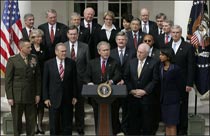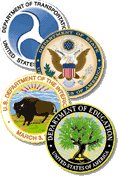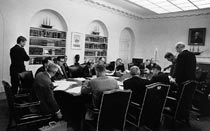| (insert your NIE or newspaper logo here) |
Weekly Online LessonOnline Lesson ArchiveGrade Level: 3-6
|
Cabinet Posts Change Hands
 Over
the last few weeks, President George W.
Bush has been facing changes in one of his most important
group of advisors.
Over
the last few weeks, President George W.
Bush has been facing changes in one of his most important
group of advisors.
White House Chief of Staff Andrew Card and Secretary of Interior Gale Norton both resigned in March 2006. Following their resignations, Bush announced his nominees for their replacements, which the Senate must approve.
The U.S. Executive Branch includes not only the posts of President and Vice President, but also the heads of 15 crucial departments and five other job positions that have been granted Cabinet-level ranking. Basically, each Cabinet member plays a key role in our government's inner workings.
For example, the White House Chief of Staff serves as Assistant to the President. The Secretary of Interior oversees our wildlife and natural resources.
During this week's lesson, you'll learn about the Executive Branch of the U.S. government, focusing on what the Cabinet members do.
Cabinet Basics
 Begin
by visiting Ben's Guide to U.S. Government, where Ben
explains the Branches of Government.
Begin
by visiting Ben's Guide to U.S. Government, where Ben
explains the Branches of Government.
Can you name one or more people involved in any of those branches? Why did our Founding Fathers decide to create the three different branches?
You can read more about the other two branches later, but for now let's just take a closer look at the Executive Branch. What is the primary purpose of this branch?
Let's zoom in on The President's Cabinet for an even closer look. Here, you'll learn how Cabinet members get their jobs and what they are responsible for. For more detailed descriptions of their responsibilities, let's jump to a similar page on The Cabinet for grades 6-8.
Can you name one specific aspect of your life that each Cabinet department is ultimately in charge of? For example, the Secretary of Energy makes sure you get electrical power to your house and school, and the Secretary of Agriculture oversees farmers who produce food for your meals.
Next, take time to explore each department's website by clicking each link. As you peruse each site, write down three or more featured topics or current events. For deeper exploration, have your classmates split up into 15 teams. Each team can learn more about one department, then report back to the whole class on what they've learned.
Cabinet Tour
 You've
got a good idea of what the Cabinet departments
do, presidency after presidency, so now let's go tour
where the Cabinet meets at the White
House, learn
about some of its history, and meet some of today's
Cabinet members.
You've
got a good idea of what the Cabinet departments
do, presidency after presidency, so now let's go tour
where the Cabinet meets at the White
House, learn
about some of its history, and meet some of today's
Cabinet members.
Let's start with Cabinet Room History by reading about a key event in the room's—and our government's—history. Then, read the overview of the President's Cabinet Room and table, check out the Photo Gallery, and open up the Cabinet Room Videos and Panoramic Tour.
Can you think of some events in our national history that likely called for the need to include every Cabinet member at the table? Identify an event and list one way in which that event affected each department.
Now let's meet today's Cabinet Members. Click on each person's photo to read his or her biography. What previous personal or professional experience does each member have that helps him or her do the job as head of their Cabinet department?
Newspaper Activities
Take one or two weeks to browse Targetnewspaper and pull out news articles highlighting national topics or issues. Sort the articles by which Cabinet department the topic or event most directly concerns. You may want to do this in teams, with one team in charge of a specific department. Summarize each article in one or two sentences, and then post each group of summaries on posterboard or directly on your classroom wall. Discuss the current events by department as a class. If a topic or event has been included for more than one department, discuss why that's the case. For an extended project, include your state and local levels of government in a similar way. You may wish to build a hierarchy of responsibility on the classroom wall, with the federal level of each department's responsibilities at the top, state level below that, and the local government level at the bottom. Place news article summaries at each level, as appropriate and discuss.
© Copyright 2006
Learners Online, Inc.
